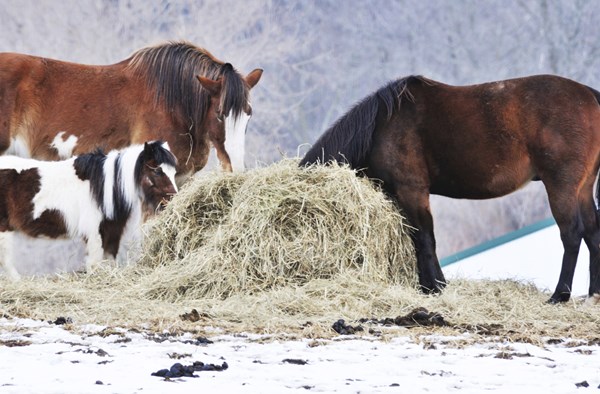 Credit: Thinkstock One disadvantage to feeding on the ground is that there is a significant amount of hay wastage–the horses trample it, soil it with manure and urine, the wind blows it away, and/or it becomes wet and moldy.
Credit: Thinkstock One disadvantage to feeding on the ground is that there is a significant amount of hay wastage–the horses trample it, soil it with manure and urine, the wind blows it away, and/or it becomes wet and moldy.When feeding horses, there seems to be two differing philosophies: One is to encourage eating off the ground, while the other presents hay in a feeder system that elevates it to at least chest level.
If you think about it, wild horses graze grasses and forbs (shrubs) with their heads in a down position for the most part. But, with feeder systems, we alter the natural defenses of the respiratory tract. There is a main advantage to horses feeding directly from the ground, and that is their enhanced ability to clear their airways of dust and debris that aerosolizes as hay is pulled apart. With an elevated feeder, the airways are assaulted significantly more than when the horse eats from the ground.
That said, there are several big disadvantages of ground feeding. An important one is that horses fed on sandy soils or decomposed granite are likely to consume a significant amount of “dirt” that can then accumulate in the bowel to cause intestinal irritation, diarrhea and/or colic. Another is that there tends to be a significant amount of hay wastage when it is fed on the ground–the horses trample it, soil it with manure and urine, the wind blows it away, and/or it becomes wet and moldy. In any case, this waste is unpalatable and accounts for huge losses that translate to expense, labor and less-efficient feed intake.
There are ways to mitigate the adverse effects of ground feeding by using rubber mats, or feeding in a stall bedded with mats or shavings. Protection of the respiratory tract when using elevated feeders relies on sound management choices: Purchase quality hay that isn’t dusty and is cured properly so it doesn’t break into small pieces. It is also possible to moisten the hay to cut down on aerosolized particles as the horses eat.
Whatever method you choose, keep in mind the importance of protection of the horse’s intestinal tract and respiratory tract while also ensuring physical safety in feeder selection.


